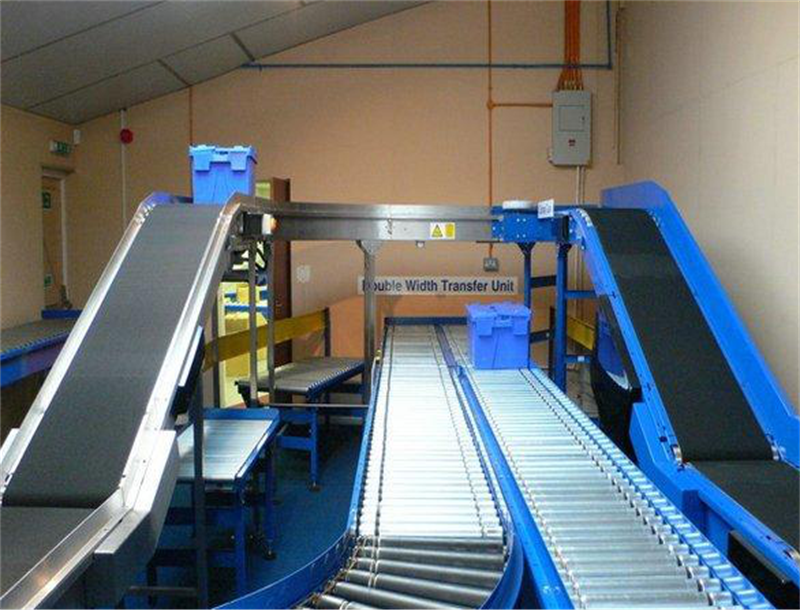
Roller conveyor manufacturers will introduce to you in detail today, roller conveyor is a continuous conveying equipment that arranges a number of rollers between the frames on both sides, which is mainly used to convey finished items with a certain regular shape or straight bottom, such as box containers, pallets, etc. Roller conveyors are divided into non-powered roller conveyors and powered roller conveyors (roller tables).
1. Non-powered roller conveyor: the surface composed of several rollers or rollers arranged between the frames can be made horizontal, and the items can be transported by manpower; It can also be made to have a small inclination angle downward, so that the item can rely on its own gravity to share the force in the conveying direction and convey it by itself.
2. Power roller conveyor: use the driving device to drive all or part of the rollers arranged between the frames, and rely on the friction between the rollers and the conveyed items to complete the conveying function.

1. Flexible layout: with straight, turning, inclined and other conveying lines, it can form various forms of conveying lines such as branches and confluences according to needs, and the conveying lines are easy to close.
2. The connection mode is simple and compact: the lifting platform can be used to make up for the height difference requirements of the process and equipment, and form a three-dimensional conveying line, which is convenient for connecting with the production process equipment.
3. Diverse functions: with gravity, power, set and other forms of conveying and storing goods, the rotation, flipping and lifting of items can be completed on the conveyor line to meet the requirements of the technological process.
Disadvantages: However, due to the small spacing of rollers, the number of rollers on the conveying line is large, and the equipment investment is higher than that of other conveying methods when the conveying distance is the same.
Introduction to the transmission mode of roller conveyor
1. Non-powered roller conveyor
There is no drive itself, the rollers rotate passively, and the items move by manpower, gravity or external push-pull devices. According to the arrangement, it is divided into two types: horizontal and inclined
A. Horizontal arrangement: rely on manpower or external push-pull devices to move items. Manpower push is used in the occasion of small item weight, short conveying distance and infrequent work. The external push and pull can be used by chain traction, belt traction and hydraulic pneumatic device push and pull, etc., which can move the item at the required speed, which is convenient for controlling the operation state, and can also realize the functions of stepping and accumulation when needed, and is used for the occasion of large weight of goods, long conveying distance and frequent work.
B. Inclined arrangement: relying on the gravity of the article as the power for the line of transportation, the structure is simple, economical and practical, but it is not easy to control the running state of the article, the impact between the items is easy, and it is not suitable to transport fragile items. It is suitable for short-distance transportation between processes and gravity high-bay warehouse.
2. Power roller conveyor
It has a driving device, and the roller rotates in an active state, which can strictly control the running state of the goods, and convey the goods accurately, smoothly and reliably according to the specified speed, which is convenient for the automatic control of the conveying process. According to the transmission mode, it is divided into three types: chain drive, belt drive and gear drive.
A. Chain drive: large bearing capacity, good versatility, convenient layout, strong adaptability to the environment, can work in places where it is often in contact with oil, water and high temperature, and is a commonly used power roller conveyor. However, the chain is easy to wear and tear when working in a dusty environment, and the noise is high when running at high speed. It is divided into single-chain drive and double-chain drive
1) The single-chain drive structure is compact, which is suitable for light load, low speed and continuous operation.
2) Double-chain drive is suitable for occasions with large load, high speed, and frequent starting and braking.
B. Belt drive: stable operation, low noise, less environmental pollution, high-speed operation is allowed, but it is not suitable for working in oily places. Belt drive: Flat belt drive, V-belt drive, O-belt drive. The carrying capacity of the flat belt drive is the largest, followed by the V-belt drive, and the O-belt drive is the smallest. Both V-belt and O-belt drives can be used in the arc section of the roller conveyor. The O-belt drive arrangement is the most flexible.
C. Gear transmission: large bearing capacity, high transmission accuracy, long service life, and strong adaptability to the environment. It is suitable for heavy load, high motion accuracy requirements, frequent start and brake.